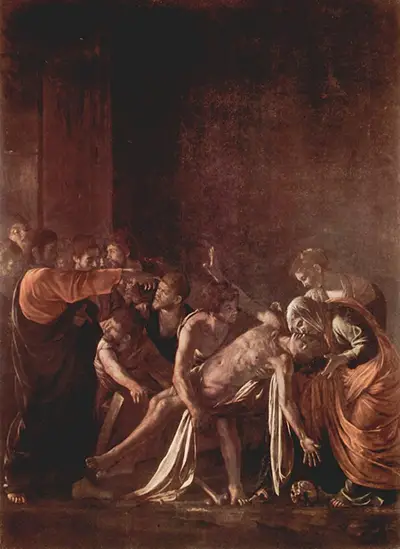 Buy Art Prints Now
Buy Art Prints Nowfrom Amazon
* As an Amazon Associate, and partner with Google Adsense and Ezoic, I earn from qualifying purchases.
The Resurrection of Lazarus, also known as The Raising of Lazarus is one of Caravaggio's most dramatic works.
It was painted between 1608 and 1609 in Sicily, after the artist's escape from a prison in Malta.
The work was ordered by Giovanni Battista de' Lazzari - a wealthy Genoese merchant and was supposed to be an altarpiece in the church of the Padri Crociferi in Messina. Lazarus, a well-known biblical figure, was the patron saint of the vendor.
The oil painting depicts Jesus Christ while bringing Lazarus back to life. The artist drew inspiration for Savior's pose from The Creation of Adam, one of the frescoes that Michelangelo painted on the ceiling of the Sistine Chapel.
Caravaggio accentuated crucial elements of the painting with light, using the "chiaroscuro" technique. He contrasted areas of darkness with beams of light to show the drama of the scene. The expression of wonder is clearly visible on well-lit faces of the onlookers.
Caravaggio portrayed himself as a man dark-haired man with his hands folded, standing behind Jesus, as one of the bystanders observing the miracle as it happens.
The upper part of the painting is very dark and void what contrasts with the lower part and makes the painting seem less crowded and overwhelming, giving the viewer a broader perspective. The artwork brings to mind The Calling of Saint Matthew - the work that Caravaggio finished a few years earlier for the San Luigi dei Francesi church in Rome.
The artist incorporated light beams on this painting as well, though in a less experimental way - only to outline the silhouettes of the persons depicted.
There were rumours that Caravaggio had a freshly buried body exhumed on which he modelled the body of Lazarus but according to John Gash, a historian and an author of the book "Caravaggio" they are most likely untrue.
According to Francesco Susinno, an 18th-century Italian writer, the first version of the artwork was cut with razors by Caravaggio after it was extensively criticised by the public.
The painting has been in an overall bad condition for a long time as a result of being kept in damp conditions and undergoing a few inept restorations between 1670 and 1951. The latest, seven-month long renovation took place in 2012. It is now stored in Museo Regionale in Messina, Italy.




